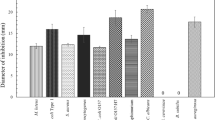Abstract
The killer toxin produced by Pichia kluyveri 1002 kills yeast strains of the genera Candida, Saccharomyces and Torulopsis, including several S. cerevisiae killer strains.
Binding of a lethal amount of the toxin to cells of S. cerevisiae SCF 1717 occurs rapidly after toxin addition. After treatment with the toxin for 10 min sensitive cells partially recovered when incubated under conditions that favor protein synthesis. Only after a lag time of 50–90 min sensitive cells changed physiologically. Killing of sensitive cells was characterized by leakage of potassium and adenosine 5′-triphosphate, decrease of intracellular pH, and inhibition of the active uptake of amino acids. These effects coincided with cell shrinkage and varied with incubation conditions.
Uptake of the amino acid leucine in sensitive cells involved two apparently distinct transport systems (Km1=0.04mm; Km2=0.46mm). The toxin showed different effects on these transport systems.
Similar content being viewed by others
References
Aiking, H. 1977. Involvement of potassium in the physiology of Candida utilis: a continuous culture study. — Thesis, Amsterdam.
Al-Aidroos, K. and Bussey, H. 1978. Chromosomal mutants of Saccharomyces cerevisiae affecting the cell wall binding site for killer factor. — Can. J. Microbiol. 24: 228–237.
Borst-Pauwels, G. W. F. H. and Dobbelmann, J. 1972. Determination of the yeast cell pH. — Acta Bot. Neerl. 21: 149–154.
Borst-Pauwels, G. W. F. H. and Peters, P. H. J. 1977. Effect of the medium pH and the cell pH upon the kinetical parameters of phosphate uptake by yeast. — Biochim. Biophys. Acta 466: 488–495.
Bussey, H. 1972. Effects of yeast killer factor on sensitive cells. — Nature New Biol. 235: 73–75.
Bussey, H. 1974. Yeast killer factor-induced turbidity changes in cells and sphaeroplasts of a sensitive strain. — J. Gen. Microbiol. 82: 171–179.
Bussey, H. and Sherman, D. 1973. Yeast killer factor: ATP leakage and coordinate inhibition of macromolecular synthesis in sensitive cells. — Biochim. Biophys. Acta 298: 868–875.
Bussey, H., Sherman, D. and Somers, J. M. 1973. Action of yeast killer factor: a resistant mutant with sensitive spheroplasts. — J. Bacteriol. 113: 1193–1197.
Bussey, H. and Skipper, N. 1975. Membrane-mediated killing of Saccharomyces cerevisiae by glycoproteins from Torulopsis glabrata. — J. Bacteriol. 124: 476–483.
Chapman, A. G., Fall, L. and Atkinson, D. E. 1971. Adenylate energy charge in Escherichia coli during growth and starvation. — J. Bacteriol. 108: 1072–1086.
Cockburn, M., Earnshaw, P. and Eddy, A. A. 1975. The stoicheiometry of the absorption of protons with phosphate and l-glutamate by yeasts of the genus Saccharomyces. — Biochem. J. 146: 705–712.
Deak, T. 1978. On the existence of H+-symport in yeasts. — Arch. Microbiol. 116: 205–211.
Eddy, A. A., Backen, K. and Watson, G. 1970. The concentration of amino acids by yeast cells depleted of adenosine triphosphate. — Biochem. J. 120: 853–858.
Fink, G. R. and Styles, C. A. 1972. Curing of a killer factor in Saccharomyces cerevisiae. — Proc. Nat. Acad. Sci. USA 69: 2846–2849.
Höfer, M. and Misra, P. C. 1978. Evidence for a proton/sugar symport in the yeast Rhodotorula gracilis (glutinis). — Biochem. J. 172: 15–22.
Imamura, T., Kawamoto, M. and Takaoka, Y. 1975. Binding of the killer factor to saké yeast cells. — J. Ferment. Technol. 53: 417–423.
Kotani, H., Shinmyo, A. and Enatsu, T. 1977. Killer toxin for sake yeast: Properties and effects of adenosine 5′-diphosphate and calcium ion on killing action. — J. Bacteriol. 129: 640–650.
Middelbeek, E. J., Hermans, J. M. H. and Stumm, C. 1979. Production, purification and properties of a Pichia kluyveri killer toxin. — Antonie van Leeuwenhoek 45: 437–450.
Niedermeyer, W., Parish, G. R. and Moor, H. 1977. Reactions of yeast cells to glycerol treatment: Alterations to membrane structure and glycerol uptake. — Protoplasma 92: 177–193.
Palacios, J. and Serrano, R. 1978. Proton permeability induced by polyene antibiotics. — FEBS Lett. 91: 198–201.
Philliskirk, G. and Young, T. W. 1975. The occurrence of killer character in yeasts of various genera. — Antonie van Leeuwenhoek 41: 147–151.
Ramos, E. H., de Bongioanni, L. C., Cuesta Casado, M. C. and Stoppani, A. O. M. 1977. Some properties of l-(14C) leucine transport in Saccharomyces ellipsoideus. — Biochim. Biophys. Acta 467: 220–237.
Rogers, D. and Bevan, E. A. 1978. Group classification of killer yeasts based on cross-reactions between strains of different species and origin. — J. Gen. Microbiol. 105: 199–202.
Rothstein, A. 1974. Relationship of cation influexes and effluxes in yeasts. — J. Gen. Physiol. 64: 608–621.
Seaston, A., Carr, G. and Eddy, A. A. 1976. The concentration of glycine by preparations of the yeast Saccharomyces carlsbergensis depleted of adenosine triphosphate. — Biochem. J. 154: 669–676.
Skipper, N. and Bussey, H. 1977. Mode of action of yeast toxins: Energy requirement for Saccharomyces cerevisiae killer toxin. — J. Bacteriol. 129: 668–677.
Somers, J. M. 1973. Isolation of suppressive sensitive mutants from killer and neutral strains of Saccharomyces cerevisiae. — Genetics 74: 571–579.
Somers, J. M. and Bevan, E. A. 1969. The inheritance of the killer character in yeasts. — Genet. Res. 13: 71–83.
Stumm, C., Hermans, J. M. H., Middelbeek, E. J., Croes, A. F. and De Vries, G. J. M. L. 1977. Killer-sensitive relationships in yeasts from natural habitats. — Antonie van Leeuwenhoek 43: 125–128.
Theuvenet, A. P. R., Roomans, G. M. and Borst-Pauwels, G. W. F. H. 1977. Intracellular pH and the kinetics of Rb+ uptake by yeasts non-carrier versus mobile carrier-mediated uptake. —Biochim. Biophys. Acta 469: 272–280.
Young, T. W. and Yagiu, M. 1978. A comparison of the killer character in different yeasts and its classification. — Antonie van Leeuwenhoek 44: 59–77.
Weerkamp, A. H. 1977. Bacteriocins of staphylococci and oral streptococci. — Thesis, Nijmegen.
Author information
Authors and Affiliations
Rights and permissions
About this article
Cite this article
Middelbeek, E.J., Stumm, C. & Vogels, G.D. Effects of Pichia kluyveri killer toxin on sensitive cells. Antonie van Leeuwenhoek 46, 205–220 (1980). https://doi.org/10.1007/BF00444075
Received:
Issue Date:
DOI: https://doi.org/10.1007/BF00444075




